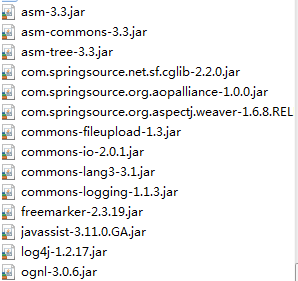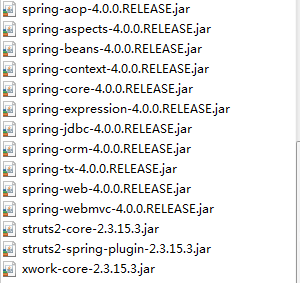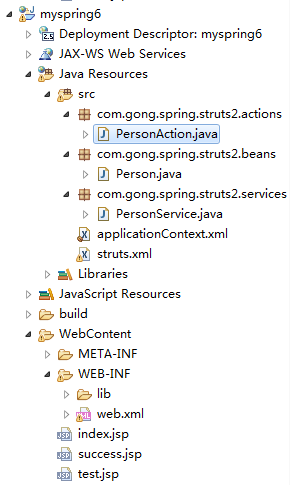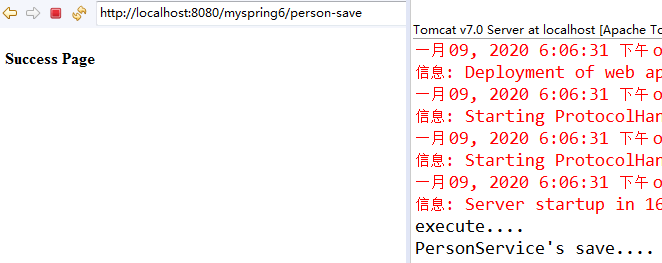spring整合struts2过程详解
人气:0这篇文章主要介绍了spring整合struts2过程详解,文中通过示例代码介绍的非常详细,对大家的学习或者工作具有一定的参考学习价值,需要的朋友可以参考下
首先将以下jar包加入到lib文件夹中:


基础目录:

Person.java
package com.gong.spring.struts2.beans;
public class Person {
private String username;
public void setUsername(String username) {
this.username = username;
}
public void hello(){
System.out.println("My name is " + username);
}
}
PersonService.java
package com.gong.spring.struts2.services;
public class PersonService {
public void save(){
System.out.println("PersonService's save....");
}
}
PersonAction.java
package com.gong.spring.struts2.actions;
import com.gong.spring.struts2.services.PersonService;
public class PersonAction {
private PersonService personService;
public void setPersonService(PersonService personService) {
this.personService = personService;
}
public String execute(){
System.out.println("execute....");
personService.save();
return "success";
}
}
基本流程如下:在PersonAction装配PersonService,在execute方法中打印相关信息并调用personService的save方法,最后返回"success"。在PersonService中的save方法输出一句话。
applicationContext.xml
<?xml version="1.0" encoding="UTF-8"?>
<beans xmlns="http://www.springframework.org/schema/beans"
xmlns:xsi="http://www.w3.org/2001/XMLSchema-instance"
xsi:schemaLocation="http://www.springframework.org/schema/beans http://www.springframework.org/schema/beans/spring-beans.xsd">
<bean id="person"
class="com.gong.spring.struts2.beans.Person">
<property name="username" value="spring"></property>
</bean>
<bean id="personService"
class="com.gong.spring.struts2.services.PersonService"></bean>
<!-- 注意: 在 IOC 容器中配置 Struts2 的 Action 时, 需要配置 scope 属性, 其值必须为 prototype -->
<bean id="personAction"
class="com.gong.spring.struts2.actions.PersonAction"
scope="prototype">
<property name="personService" ref="personService"></property>
</bean>
</beans>
在applicationContext中配置相关bean。
stuts.xml
<?xml version="1.0" encoding="UTF-8" ?>
<!DOCTYPE struts PUBLIC
"-//Apache Software Foundation//DTD Struts Configuration 2.3//EN"
"http://struts.apache.org/dtds/struts-2.3.dtd">
<struts>
<constant name="struts.enable.DynamicMethodInvocation" value="false" />
<constant name="struts.devMode" value="true" />
<package name="default" namespace="/" extends="struts-default">
<!--
Spring 整合 Struts2 时, 在 Struts2 中配置的 Spring 的 Action 的 class 需要指向 IOC 容器中该 bean 的 id
-->
<action name="person-save" class="personAction">
<result>/success.jsp</result>
</action>
</package>
</struts>
在struts.xml中配置action时,class需要使用applicationContext.xml中bean的id。结果返回给success.jsp。
web.xml
<?xml version="1.0" encoding="UTF-8"?>
<web-app xmlns:xsi="http://www.w3.org/2001/XMLSchema-instance" xmlns="http://java.sun.com/xml/ns/javaee" xsi:schemaLocation="http://java.sun.com/xml/ns/javaee http://java.sun.com/xml/ns/javaee/web-app_2_5.xsd" id="WebApp_ID" version="2.5">
<!-- 配置 Spring 配置文件的名称和位置 -->
<context-param>
<param-name>contextConfigLocation</param-name>
<param-value>classpath:applicationContext.xml</param-value>
</context-param>
<!-- 启动 IOC 容器的 ServletContextListener -->
<listener>
<listener-class>org.springframework.web.context.ContextLoaderListener</listener-class>
</listener>
<!-- 配置 Struts2 的 Filter -->
<filter>
<filter-name>struts2</filter-name>
<filter-class>org.apache.struts2.dispatcher.ng.filter.StrutsPrepareAndExecuteFilter</filter-class>
</filter>
<filter-mapping>
<filter-name>struts2</filter-name>
<url-pattern>/*</url-pattern>
</filter-mapping>
</web-app>
在web.xml中需要两个部分:一个是让springIOC容器在web应用服务加载时就进行创建。另一个就是配置struts2的过滤器。
index.jsp
<%@ page language="java" contentType="text/html; charset=UTF-8" pageEncoding="UTF-8"%> <!DOCTYPE html PUBLIC "-//W3C//DTD HTML 4.01 Transitional//EN" "http://www.w3.org/TR/html4/loose.dtd"> <html> <head> <meta http-equiv="Content-Type" content="text/html; charset=UTF-8"> <title>Insert title here</title> </head> <body> <a href="person-save" rel="external nofollow" >Person Save</a> </body> </html>
sucess.jsp
<%@ page language="java" contentType="text/html; charset=UTF-8" pageEncoding="UTF-8"%> <!DOCTYPE html PUBLIC "-//W3C//DTD HTML 4.01 Transitional//EN" "http://www.w3.org/TR/html4/loose.dtd"> <html> <head> <meta http-equiv="Content-Type" content="text/html; charset=UTF-8"> <title>Insert title here</title> </head> <body> <h4>Success Page</h4> </body> </html>
test.jsp
<%@page import="com.gong.spring.struts2.beans.Person"%>
<%@page import="org.springframework.web.context.support.WebApplicationContextUtils"%>
<%@page import="org.springframework.context.ApplicationContext"%>
<%@ page language="java" contentType="text/html; charset=UTF-8"
pageEncoding="UTF-8"%>
<!DOCTYPE html PUBLIC "-//W3C//DTD HTML 4.01 Transitional//EN" "http://www.w3.org/TR/html4/loose.dtd">
<html>
<head>
<meta http-equiv="Content-Type" content="text/html; charset=UTF-8">
<title>Insert title here</title>
</head>
<body>
<%
//1. 从 appication 域对象中得到 IOC 容器的实例
ApplicationContext ctx = WebApplicationContextUtils.getWebApplicationContext(application);
//2. 从 IOC 容器中得到 bean
Person person = ctx.getBean(Person.class);
//3. 使用 bean
person.hello();
%>
</body>
</html>
启动tomacat服务器之后:

点击Person Save:

会跳转到succes.jsp,并在控制台输出相应的语句。
说明spring整合struts2基本是成功的了。
您可能感兴趣的文章:
- Spring与Struts整合之让Spring管理控制器操作示例
- struts2+spring+ibatis框架整合实现增删改查
- WebSocket整合SSM(Spring,Struts2,Maven)的实现示例
- Spring+Hibernate+Struts(SSH)框架整合实战
- struts+spring+hibernate三个框架的整合
- Spring整合Struts2的两种方法小结
- 详解JAVAEE——SSH三大框架整合(spring+struts2+hibernate)
- struts2.2.3+spring3.1.0+mybatis3.1.0框架整合集成简单demo
- SSH框架网上商城项目第1战之整合Struts2、Hibernate4.3和Spring4.2
- struts2 spring整合fieldError问题
- Spring与Struts整合之使用自动装配操作示例
加载全部内容